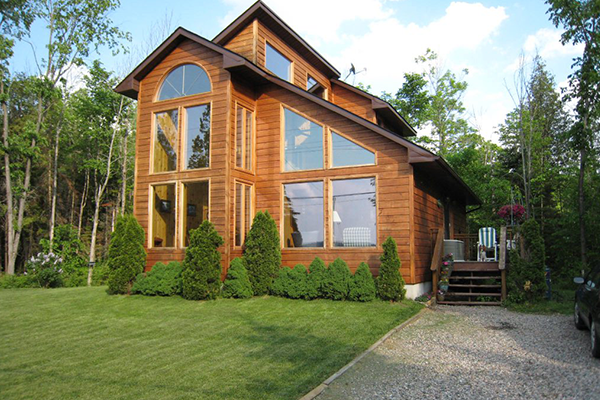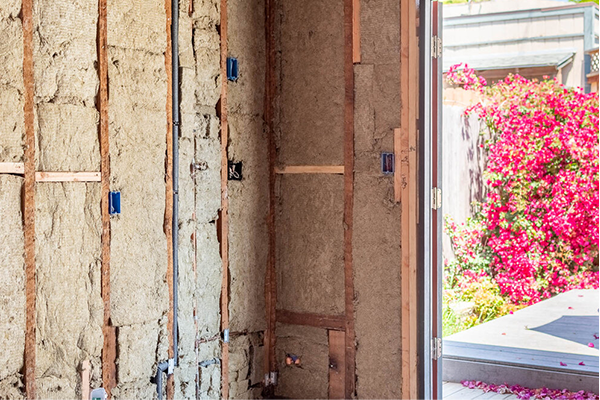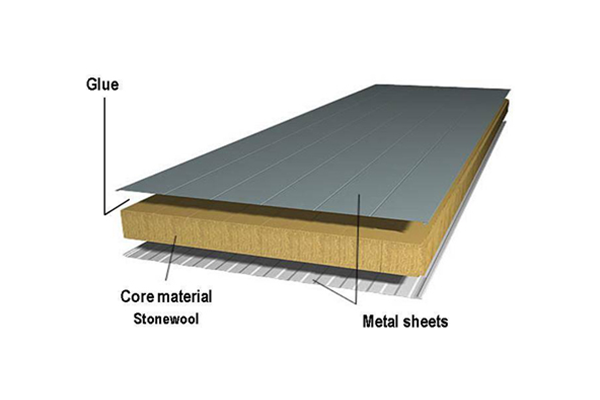Sound pollution is prevalent problem in industry section. Nowadays sound insulation not only is used in industrial section but household and commercial sections are also taking advantage of them. Correspondingly, in developed country one of the factors by which the value of a building is assessed is, apart from thermal insulation, the property’s sound insulation. Despite all the attention has been put on this issue in developed country, unfortunately, this is ignored in our country, especially in commercial and household sections. In this part the effort is to introduce technical concepts of sound insulation for artisans and construction practitioners. Our hope is, by illustrating these concepts, to help in the establishing of a new culture valuing sound insulation and at the same time individuals health.
To investigate Physics of sound, it’s Publication, its passing and dying criteria, and sound insulation: getting to know the following rudimentary concepts is necessary.
What is sound?
In physics, Sound is a mechanical vibration of a gas, liquid or resilient solid in the space.
Sound is a form of mechanical energy which occurs when the particles vibrates around its center of balance.
Sound (and generally all waves) is defined and described with parameters some which are:
Wavelength (λ), frequency (f), amplitude (d) and velocity of the wave(c)
- Frequency (f):
Frequency is the occurrence number for an event repetition per one unit of time. It is also referred as the temporal frequency. A period is the duration of one cycle in a repeating event, so a period is the reciprocal to a frequency. Frequency is shown by HZ (Hertz).
- Wavelength (λ):
The distance between particles of the same phases, for instance, the distance between all the particles which are at their maximum amplitude. Wavelength is shown by meter [m].
- Velocity of the wave:
The velocity at which a wave phase propagates at a certain frequency and is shown by m/s.
- Amplitude (d):
The maximum distance in which particle replacement from the center of swing occurs,and its unit is meter (m)
- Audible Frequency Range:
The human ear can hear frequencies 20Hz to 20000Hz; Human ear cannot detect the frequency below and above this range. In the following diagram, frequency and intensity of sound audible by the human ear is presented.
Octave bands:
To review, evaluate, rank and perform other technical issues relating to sound insulation and sound phenomena, apart from sound power levels, Frequency distribution is also vitally important.
Usually a sound is composed of several different frequencies. Additionally, the sound analysis is normally performed in a wide frequency range (20Hz-20000Hz).
In order to perform frequency analysis, frequency amplitude must be divided into smaller intervals. This can be done using two ways: First, intervals have equal length.For example, the intervals have 10Hz long and the frequency range is broken into [0-10Hz], [10-20Hz], … [19990-20000]. Second, the ratio of large numbers as to small numbers is an equal interval, and normally the bigger number is usually as twice as the smaller one. For example, it is divided into ranges: [90-180], [180-360], [360-72]. However, such intervals which the ratio is 2 are called octave bands.
Dividing frequency range by octave bands method in terms of human hearing is much better. The most common octave band is Octave 1/3 (one third) in which the ratio of the large to the small numbers of interval is three times the square root of two ( ) (approximately 1/26). Octaves with 1/12 and 1/24 ratios are also used in the frequency analysis.
- Decibel (dB):
dB is a logarithmic unit (with the base 10) to show the relationship of two quantities. This can be compared with the ratios of pressure, power, sound intensity, voltage, or any other parameter that they can be measured. In acoustic sound pressure level (p by Pascal unit Pa) and sound power levels (P by Power Unit W) and the sound intensity (I by unit W/m2) are describedby decibel or by a reference value. In fact, any measureable parameter can be expressed in terms of decibels.
- Sound Power:
Sound is a type of mechanical wave and every wave is energy therefore sound is mechanical energy that it called acoustic energy. Energy output per unit time of the audio source can be called sound power and its unit is watt [W] .
Sound Power Level dB
LW = 10 Log (P/P0) Reference value P0 = 10-12W
For example, the sound source by sound power 1W, sound power levels are equal
LW = 10 * Log (1 / 10-12) = 120 dB
- Sound Pressure:
Sound pressure or acoustic pressure, is the square of the mean-square pressure (atmospheric pressure) that is created by the crossing of sound through the space.And it is measured by Pascal units.
Sound pressure level (SPL) with dB is expressedby a reference level.
Sound Pressure Level dB
LP = 10 log (p/P0) Reference value P0 = 20μPa =20*10-6 Pa
Sound Pressure Level – SPL:
When the sound is diffused, its energy becomes low. For measuring sound intensity in different distance, sound pressure level is used. Assuming that sound is diffused spherical in Space and there is not any barrier between diffusion source and location of measuring, the level of sound pressure is as follow:
LP = LW + 10 * Log (1/4πr2) dB
For example, the sound source by the sound intensity 60dB, 23dB at a distance of 20 meters has the sound intensity23dB and sound intensity equal to 17dB at a distance of 40 meters.
LP(20mm) = 60dB + 10Log(1/4π202) = 23dB
LP(40mm) = 60dB + 10Log(1/4π402) = 17dB
Sound Intensity:
Sound intensity can be defined as the average amount of energy that sound transmits it in a unit of area and its unit iswatt per square meter [W/m2]. Sound intensity level is expressed in decibels relative to a reference level. Reference level of sound intensity I0 is defined as the sound pressure and sound intensity along the diffusion in a sound field have a same value. therefore, sound intensity often is used instead of the pressure sound.
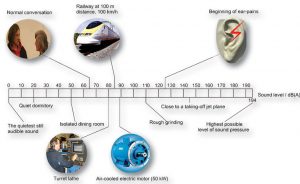
Sound Intensity Level dB
LI = 10 log (I/I0) Reference value I0 = 10-12 W/m2
So as to investigate and evaluate the performance of sound insulation different model and various factor may be used. The most well-known and also common factors among others are: Sound reduction index normalized, Sound Transmission Class. However, the latter comes from American standards.
Velocity of sound:
Wave velocity in the air is independent of frequency and it is only a function of ambient temperature.
c = 331.4+0.607t m/s
Where t is the temperature in celsius degrees.
Sound velocity is equal to c ≈ 340m / s in a normal air (about 200C).
Sound velocity is variant in other materials with 200C like as:
Glass: 5500-6000 m/s
Aluminum / Steel: 5100 m/s
Wood: 3400-4500 m/s
Cement / Concrete: 4000 m/s
Brick: 3600m/s
Ice: 3100 m/s
Water: 1500 m/s
Mineral Wool: 180 m/s
There is a relationship function between the velocity, frequency and wavelength.
The sound velocity is only a function of the air’s temperature therefore at a constant temperature the sound velocity would be steady. Accordingly, when the frequency increases, wavelength decreases whereas when frequency decreases, wavelength increases.
Sound transmission mechanisms
There are usually two types of sound transmission mechanism:
1. Airborne
2. Impact
The mechanism of impact:
Noisepollution is transmitted from the structure components, like the sound of people walking the top floor, hitting the neighbor’s wall, closing the door. The other name which Impact sound transmission mechanism called is Structure Borne Sound is also called.
For sound insulation, all of the noise transmission mechanisms must be considered. Doors, windows, grilles and components of building must be insulated to prevent ambient sound pollution. Fortunately, many of the materials that are used in thermal insulation (like rock wool) is also used as sound insulation so there will be no need to add additional materials.
Sound absorption and sound reduction:
It should be considered that sound insulation and sound absorption are different. To shed light, sound insulation is a material that reduces the sound transmission and sound absorption is a material that prevented from sound reflexing.
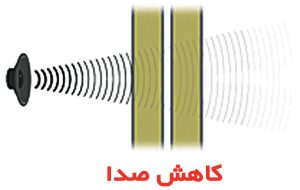
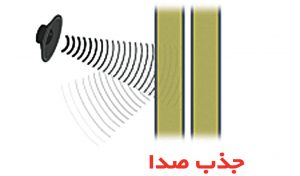
Sound absorption sound reduction
When sound meets and hits a barrier like any others wave: a part of it will rebound and other part will transmit inside the barrier. A part of the inside transmitted wave will be absorbed, which depends on the damping feature of barrier, and the other part will pass the barrier and transmit in the space. To put it another way:
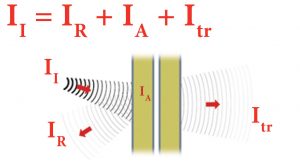
III :The initial intensity of hitting wave
IR:The intensity of rebounded wave
IA:The intensity of damping wave
Itr:The intensity of transmitted wave from the barrier
Sound absorption coefficient
This is a Property of a material that indicates how much material can absorb an emitted wave. This ratio is always a number between zero and one, by which number one represents 100% of absorption and number zero indicates 0% absorption. Larger number always doesn’t represent better sound absorption coefficient of material for acoustic insulation and it affects the reverberation time. However, appropriate number of sound absorption coefficient must be determined in accordance with the construct and the room.
Attenuation
When sound propagates through an environment (whether liquid or solid), its energy will be released. This phenomenon is due to two reasons: First propagation and refraction of wave and second absorption; and attenuation is created from combination of wave refraction and absorption.
Rate of reduction
This term is the rate of decreasing sound intensity or sound attenuation after the sound sources in the room goes off. In a room with a constant temperature, the rate is constant and is measured proportionally to the reverberation time.
Critical frequency
For acoustic insulation in buildings, critical frequency occurs when the velocity of sound in air is equal to velocity of wave propagation in the partition or panel. In critical frequency, the main mechanism of sound propagation will change dramatically and sound reduction coefficient of panel decreases noticeably. Critical frequency is related to the type of insulation material and the panel thickness.
Reverberation time
Reverberation time is the time that will take for sound intensity to reduce down to 60dB after all audio sources have went off.
Noise Criteria
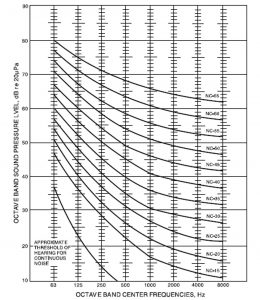 The sensitivity of human hearing must be considered in the time of acoustic design of ventilation systems. Accordingly, the loudness of the sound cannot be stated with an absolute and accurate number because people have different hearing sensitivity. Also, the human ear shows Different reactions to the sounds with different intensities and different frequencies. For example, a sound with a certain sound intensity, which frequency may be “long”, but the same sound intensity at other frequencies, will not make much noise. Noise Criteria is defined for acoustic engineering design. These criteria are plotted form the pattern of sound intensity (in dB) and frequency (intermediate frequency octave bands). These charts represent the maximum amount of sound at each frequency. To facilitate the design, engineering acoustics, the measure is defined as a measure of noise (Noise Criteria). These criteria form the pattern of sound intensity (in dB) and frequency (intermediate frequency octave bands) is plotted. These charts represent the maximum amount of sound intensity at each frequency. For example, an NC-35, the sound intensity in the frequency domain should be in the following of NC = 35.
The sensitivity of human hearing must be considered in the time of acoustic design of ventilation systems. Accordingly, the loudness of the sound cannot be stated with an absolute and accurate number because people have different hearing sensitivity. Also, the human ear shows Different reactions to the sounds with different intensities and different frequencies. For example, a sound with a certain sound intensity, which frequency may be “long”, but the same sound intensity at other frequencies, will not make much noise. Noise Criteria is defined for acoustic engineering design. These criteria are plotted form the pattern of sound intensity (in dB) and frequency (intermediate frequency octave bands). These charts represent the maximum amount of sound at each frequency. To facilitate the design, engineering acoustics, the measure is defined as a measure of noise (Noise Criteria). These criteria form the pattern of sound intensity (in dB) and frequency (intermediate frequency octave bands) is plotted. These charts represent the maximum amount of sound intensity at each frequency. For example, an NC-35, the sound intensity in the frequency domain should be in the following of NC = 35.
The system design and acoustics for optimal NC needs are defined. Appropriate amount of NC is defined with design needs and optimal acoustic system. In most cases, the NC-45 is appropriate for acoustic insulation in the ventilation system. Noise criteria, contrary to being useful and important parameter in the design of ventilation systems, can make mistake in sound insulation.
Lower frequencies won’t be absorbed as much as higher frequencies by acoustic insulation (Of course, this principle is general for sound attenuation). So 63Hz and 125Hz octave bands should be considered for acoustic insulation in ventilation systems because the noise in these bands can cause the vibration of system.


